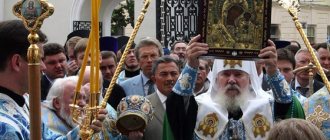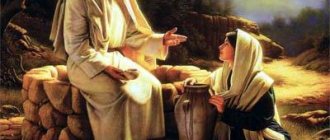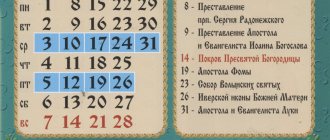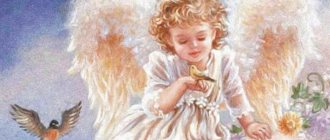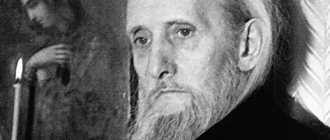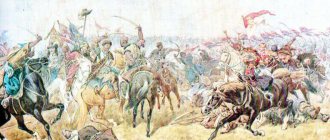On the thirtieth of May there are two holidays celebrated by Christians of the Eastern rite. We try to promptly inform readers about religious celebrations that are honored by believers in the Russian Federation. On the pages of our website you can familiarize yourself with the days of veneration of saints, as well as holidays that are based on events from the Holy Scriptures. Readers are offered not only the date and history of the holidays, but also traditions and rituals that have existed since the times of the ancient Slavs.
Orthodox and church holidays and fasts
Today is an Orthodox church holiday: * Great Martyr Euphemia the All-Praised (memory of the miracle by which Orthodoxy was established, 451). * Equal to the Apostles Grand Duchess Olga of Russia, in holy baptism Helena (969) and other saints whose names we remember on this day... Tomorrow:
* Martyrs Proclus and Hilary (c. 98-117).
* St. Michael Malein (962) and other saints whose names we remember on this day... Holidays are expected: 07/26/2021
- * Cathedral of the Archangel Gabriel.
* St. Stephen Savvait (794) and other saints whose names we remember on this day... 07.27.2021
- * Apostle Aquila of the 70 (I) and other saints whose names we remember on this day...
07.28.2021
- * Martyrs of Kirik and Julitta, his mother (c. 305). *** Equal to the Apostles Grand Duke Vladimir, in holy baptism Vasily, Baptist of Rus' (1015) and other saints whose names we remember on this day...
All Orthodox and church holidays and fasts...
Orthodox Saints of God
The holy saints of God show special love and mercy to those who honor their holy memory.
It seems to many that the saints are far from us. But they are far from those who have withdrawn themselves, and very close to those who keep the commandments of Christ and have the grace of the Holy Spirit.
The holy saints in their earthly life turned to God for help in healing their ailments, sorrows and deliverance from temptations, asking God that even after death He would honor them with the gift of helping people in various cases of life.
The saints have reached the Heavenly Kingdom and there they see the glory of our Lord Jesus Christ; but by the Holy Spirit they also see the suffering of people on earth. Many holy saints of God received special grace from God, and He deigned them to be intercessors before Him for deliverance from our sorrows and bodily ailments, in which they themselves were tempted.
The saints rejoice at our repentance and mourn when people leave God and become like foolish cattle. They feel sorry that people live on earth, not knowing that if they loved each other, then there would be freedom from sin on earth: and where there is no sin, there is joy and gladness from the Holy Spirit, so that, wherever you look, everything sweet, and the soul wonders why it feels so good, and praises God. The saints hear our prayers and have the power from God to help us. The entire Christian race knows about this. We must remember: in order for a prayer to be heard, one should pray to the holy saints of God with faith in the power of their intercession before God, in words coming from the heart.
In our prayers we turn to the Lord God, to His Most Pure Mother - our Intercessor and Helper, to the holy Angels and holy people - the saints of God, because for their sake the Lord God is more likely to hear us sinners, our prayers. The Saints have different names: prophets, apostles, martyrs, saints, saints, unmercenaries, blessed, righteous, confessors. more>>
The Lord says: “When you light a candle, you do not put it under a bushel, but on a candlestick, and it gives light to everyone in the house. So let your light shine before people, so that they may see your good deeds and glorify your Father in heaven” (Matthew 5:15-16). Saints are bright stars that show us the way to the Kingdom of Heaven.
Let us treasure the closeness of the holy saints of God to God and turn to them for help, remembering that they love us and care about our salvation. It is good to pray to the holy saints of God on those days when the Church celebrates their memory.
«Holy Saints of God, pray to God for us!»
Saints: life, memory, suffering...
Christian holidays
Christianity, like any religion, on certain days of the calendar honors saints or celebrates events in the life of the church. Christian holidays are rooted in ancient ritual traditions associated with specific stages, types of economic activity, and the annual astronomical or calendar cycle. Conventionally, they are divided into All-Christian (recognized by the Orthodox, Catholic, and most Protestant churches) and confessional (celebrated only by individual denominations). The most important of them relate to the twelve holidays - the twelve most important holidays after Easter, which the church celebrates with solemn services. Nativity . This is one of the main religious holidays of Christianity, associated with the birth of Jesus Christ. In Catholicism it is celebrated on December 25, in Orthodoxy (belongs to the twelfth holidays) - on January 7. Establishing itself in different countries, this holiday absorbed the rituals and customs of other religions and folk holidays, acquiring new features that corresponded to Christian dogmas. The very tradition of Christmas reaches its origins in the original cult actions. The main role in its dogmatic sense the church assigns to the teaching about the birth of Jesus Christ, who appeared to atone for the sins of people, to show humanity the path to salvation. Indeed, in Ancient Egypt, for example, on January 6 they celebrated the birthday of the god of water, vegetation, and owner of the afterlife - Osiris. In Ancient Greece, the birth of Dionysus was celebrated on the same day. In Iran, on December 25, they celebrated the birth of the god of the sun, purity and truth - Mithra. In Kievan Rus, the celebration of the Nativity of Christ came along with Christianity in the 10th century. and merged with the ancient Slavic winter holiday - Christmastide [lasted for 12 days - from December 25 (January 7) to January 6 (19). The Orthodox Church tried in every possible way to replace them with the holiday of the Nativity of Christ, but the holidays and customs existing among the Eastern Slavs are so deeply rooted that it is forced to combine church holidays with folk ones. Thus, the church combined carols with the gospel story about the Star of Bethlehem and reported on the birth of Christ. “Pagan” carols turned into the walking of Christoslavs with a star from house to house. Children were widely involved in glorifying Christ. The believers thanked them with gifts. Since 1990, Christmas Day has been an official holiday in Ukraine and Russia. Baptism of the Lord (Baptism, Blessing of Water, Epiphany). It is one of the main holidays in Christianity. In Orthodoxy it belongs to the twelve holidays. Catholics celebrate on the 6th, Orthodox on January 19. It was introduced in memory of the baptism of Jesus Christ in the Jordan River by John the Creator. It is also called the Epiphany, because, according to the Gospel, during Jesus’ baptism, God the Holy Spirit descended from heaven in the form of a dove. In Christianity it was introduced in the 2nd half of the 2nd century, and was first celebrated together with the Nativity of Christ. In the 4th century. This day began to be celebrated separately. The Church views it as a “holiday of enlightenment” of peoples, since according to teaching, it was from Baptism that Jesus began to enlighten them with the light of the Gospel truth. This holiday has always been celebrated very solemnly. Its main rite is the blessing of water in the church and in the wormwood. A procession of the cross went to the ice hole, and solemn prayers were held. The blessing of water in churches continues to this day. Sprinkling with water existed in many pre-Christian religions. Spiritualizing natural phenomena, people also spiritualized water - an important source of life. Christianity in the early stages of its development did not know the rite of baptism; it borrowed it somewhat later from ancient cults, which assigned an important role to the rite of “cleansing” a person from any “filth”, “unclean” ones with the help of water. According to ancient beliefs, water cleansed people from “evil spirits,” “evil spirits.” Therefore, ancient peoples had a custom of sprinkling water on newborns. Meeting . It is celebrated as one of the twelve holidays on February 15 on the occasion of the meeting (contemplation) of the righteous Simeon with the baby Jesus, whom his parents brought to the Jerusalem Temple on the fortieth day after birth to present to God. It was then that Simeon predicted to Jesus his messenger mission as the Savior of people. This is stated in the Gospel of Luke. By introducing the holiday, the church cared not only about spreading the ideas of Christianity, but also about “providing truth to the facts” of the biography of Christ, emphasizing the obligation of believers to bring babies to the temple within 40 days after birth. In addition, the church tried to protect Christians from ancient cults, since the Romans in February served “purification”, repentance, fasted, believing that before the start of spring field work it was necessary to “cleanse themselves from sins” and “evil spirits” by making sacrifices to spirits and gods; The main cleansing ritual took place on February 15, when people with torches in their hands drove out the evil spirits of winter cold and disease. For a long time, supporters of Orthodoxy did not recognize the Presentation. Later they provided him with the meaning of the holiday purified. This is exactly how it appeared in Rus', establishing itself mainly as a church holiday. In the popular consciousness, Meeting marked the end of winter and the beginning of spring household chores, as evidenced by the popular belief: “At Meeting, winter meets summer.” Entry of the Lord into Jerusalem . This twelfth holiday is celebrated on the last Sunday before Easter. Its common name is Palm Sunday, which is the eve of Holy Week, timed to “remember the suffering of Christ.” According to the calendar, it is directly adjacent to Easter and does not have a fixed date. It was introduced in the 4th century. as an important stage in preparation for Easter. It is based on the biblical legend of the entry of Jesus Christ with the apostles into Jerusalem, accompanied by the creation of see. The people joyfully greeted the Son of God with palm branches. The day before, Jesus did one of the most important things - he revived Lazarus. In Rus', the ritual significance of palm branches has been transferred to willow branches, which are blooming at the present time, and, according to popular belief, protect against evil spirits. The celebration of the Lord's entry into Jerusalem is intended to encourage believers to open their hearts to Christ's teachings about the resurrection and eternal salvation, as did the inhabitants of Ancient Jerusalem. Ascension of the Lord . It is celebrated on the fortieth day after Easter. And the very moment of the ascension to heaven of Christ, resurrected after the execution, completes his earthly biography. It is not very common in everyday life and remains strictly ecclesiastical. Its content generates in believers the idea of the frailty of earthly life and directs them toward Christian asceticism in order to achieve “eternal life.” Christian theology claims that the ascension of Christ opens the way for the righteous to heaven, to resurrection after death. This idea existed long before the advent of Christianity. Beliefs in the ascension to heaven of people, heroes and gods were common among the Phoenicians, Jews and other peoples. Trinity (Pentecost). A holiday established in honor of the descent of the Holy Spirit on the disciples of Christ on the fiftieth day after his resurrection, as a result of which they spoke in different languages that they did not know before. It is called upon to focus the attention of believers on the voice of the church, which carries the “word of God,” and to attract them to preach Christianity in other “languages,” that is, to other peoples. Celebrated on the fiftieth day after Easter. In Orthodoxy it belongs to the twelve holidays. The concept of the divine trinity existed long before Christianity. In the process of the formation of the Christian religion, it became necessary to connect it with the stories of the Old Testament. Therefore, in the New Testament books, Christ is presented as the son of the Hebrew god Yahweh, as a hypostasis of the one God, which indicates the step of Christianity from polytheism to monotheism. According to Christianity, it borrowed many Jewish holidays, including the Feast of Pentecost. Among the ancient Jews, it arose with their transition to agriculture and was associated with the completion of the harvest, which lasted “seven weeks,” that is, seven weeks, accompanied by the bringing of bread from the new harvest to local field spirits and deities. Christianity gave him a new justification. Among the majority of Eastern Slavs, the Trinity holiday merged with the local holiday - Semik (another name is “green holidays”), borrowing its everyday meaning. The ancient Slavs associated semik with the end of spring work, trying to appease the spirits of vegetation during the period of flowering and harvesting. An important element of the Orthodox holiday of Trinity is the commemoration of dead relatives (funeral Saturday). In Ukraine, since 1990, Trinity is an official holiday. Saved . This is one of three holidays dedicated to the Savior Jesus Christ. It is based on the Gospel story about the transformation of Christ, who at the end of his earthly life led his disciples (Peter, James, John) to the mountain and during prayer completely changed: his face shone, his clothes became white, shiny, and his voice came from heaven confirmed his divine origin. Christian teaching claims that Jesus wanted to strengthen the faith of his disciples and prove to them that he was the Son of God. It is with this event that the Feast of the Transfiguration (“Apple” Spas), which is celebrated on August 19, is associated. On this day, they not only glorify Jesus Christ, but also sanctify apples and other fruits (according to the folk custom of that time, they can be consumed). An important feature of the Savior, like many other holidays, is the combination of Christian pathos with calendar rituals and customs of cleansing from evil spirits. For example, during the “honey” celebration (“Makovei”), which takes place on August 14, fresh honey is blessed in the church. It was erected in 1164 in honor of the Byzantine victory over the Muslims. This day is especially revered in Russian Orthodoxy, since it is believed that it was on August 14 that the Grand Duke of Kiev Vladimir was baptized. The third, the “grain savior,” is celebrated on August 29, coinciding with the end of the harvest and the beginning of the winter sowing. Christianity associates it with reverence for the miraculous image of Christ, imprinted on a towel and handed over to Abgar, the king of Edessa. In many parishes there are also patronal (church) feasts of the Savior. Exaltation of the Holy Cross . One of the twelve holidays dedicated to the cult of the Cross as a symbol of the Christian faith. The church connects several events with the cross. According to legend, the Roman Emperor Constantine, before one of his largest battles, had a vision: an illuminated cross in the sky with the inscription “Hereby conquer!” That same night, Jesus Christ himself appeared to the emperor in a dream and advised him to take into battle a banner with the image of a cross. Constantine did so, in addition, he ordered his legionaries to paint the sign of the cross on their shields. Constantine was victorious in the battle and from then on believed in the miraculous power of the cross, although historical facts show that to commemorate the victory, Constantine ordered the minting of coins with the image of pagan gods, which he believed helped him in the battle against his enemies. The Church established this holiday in memory of the receipt by the mother of the Roman Emperor Helen in the 4th century. the cross on which Jesus Christ was crucified. So that the people could see it, the cross was raised (erected) on Mount Golgotha, where Christ was executed, and on the place where the cross was found, a temple was built, the consecration of which took place on September 13, 335. The Exaltation of the Cross of the Lord is solemnly celebrated on September 27. It is accompanied by magnificent rituals. During the service, a cross decorated with flowers is brought out and placed in the middle of the temple. The ceremony is accompanied by ringing and church chants. Believers revere the cross as a symbol of Christianity - a symbol of redemption, suffering and salvation, believing that every person, like Christ, must overcome his own “way of the cross.” Mother of God holidays . They cover holidays in honor of the Virgin Mary - the mother of Jesus Christ (Theotokos). These are the Nativity of the Theotokos, the Entry into the Temple of the Theotokos, the Annunciation of the Blessed Virgin Mary, the Feast of the Dormition, the Intercession (the first four belong to the Twelfth) and many holidays in honor of the “miraculous” icons of the Theotokos. In the honoring of Mary the Mother of God, there are traces of veneration by the ancient peoples of the goddess of the earth, who gave birth to the Savior, the son of God - the god of vegetation. The creation of the image of the Christian Mother of God was influenced by the ideas of the ancient Egyptians about the goddess Isis. Christianity depicts the Mother of God as the “queen of heaven,” a winged celestial being “shrouded in the sun.” On her head is a wreath of twelve stars. The ancient Egyptian goddess Isis was also portrayed as a heavenly queen, believing that she gave birth to a divine son, the Savior Horus. The Christian Mother of God has common features with the goddess of the Syrians and Phoenicians - Astarte. Ancient peoples worshiped these goddesses, considering them deities of the fertility of the earth and livestock, and patrons of agriculture. The church borrowed the idea of the Immaculate Conception from pre-Christian religions. According to the myths of the peoples of the Ancient East, Mithra, Buddha, and Zoroaster were born from immaculate mothers. It was these myths that served to create the Christian legend about the “immaculate conception” of the Virgin Mary. Nativity of the Virgin Mary (Malaya Prechistaya). The church associates it with the ancient agricultural autumn holidays, timed to mark the end of the harvest. On this day, it is emphasized that the Mother of God is a great righteous woman, a helper and intercessor of people, the patroness of agriculture, and with the “birth of Christ” she took the first step towards their “eternal salvation.” Celebrated on September 21st. Introduction to the Temple of the Virgin Mary . Connected with the tradition of three-year-old Mary being raised in the Jerusalem Temple. By establishing this holiday, the church primarily pursued the goal of convincing parents of the need to bring their children to church at an early age. Celebrated on December 4th. Annunciation of the Blessed Virgin Mary . It is celebrated on the occasion of Mary receiving news from the Archangel Gabriel that she will give birth to a child from the Holy Spirit. In Rus', the church associated this holiday with the beginning of spring field work (“blessing” of seeds, etc.) and signs of the future harvest. Celebrated on April 7th. Dormition . The Church celebrates it as the day of remembrance of the Mother of God. The church interpretation of this holiday is in many ways reminiscent of ancient Syrian legends about the death of Cybele, the goddess of fertility. In Rus', the holiday of the Assumption merged with the ancient Slavic pagan holiday of harvesting and sacrificing bread and fruits to the spirits. Celebrated on August 28th. Intercession of the Virgin Mary . This holiday is associated with a vision of the Virgin Mary, which allegedly appeared in 910 in the Blachernae Church of the Virgin Mary in Constantinople. During the night service, the holy fool Andrei, who was canonized, and his disciple Epiphanius allegedly saw how. The Mother of God, surrounded by angels and saints, appeared above them, prayed for the salvation of the world from adversity and suffering, spreading a white veil over everyone. The holiday came to Rus' along with Orthodoxy; the church used it to supplant the autumn pagan holidays, which were held after the end of field work. It is celebrated on October 14. In Ukraine, the celebration of the Intercession is very revered; it has absorbed the traditional honoring of women, mothers, the feminine principle in general, personified in the image of the mother earth. The Ukrainian Cossacks and UPA soldiers had a special attitude towards this holiday. Easter (Easter). This is one of the most significant Christian religious holidays. It was established by the first Christians in memory of the suffering, death and resurrection of Jesus Christ. We also recommend that you read the article - the sun shines on Easter. Historically, the holiday comes from the custom of some ancient peoples of the Middle East (Babylonians, Egyptians, Jews), who were engaged in cattle breeding, to sacrifice lambs and calves from the first litter to the spirits during the spring holiday. They believed that by doing this they were courting evil spirits, and they would no longer destroy livestock and send diseases to them. With the transition to agriculture, bread, cakes, fruits, etc. baked from the grain of the new harvest were offered as an expiatory sacrifice to the spirits. These agricultural holidays merged with cattle-breeding Easter and adopted its name. they were united by the hope of the miraculous good power of deities who die and are resurrected. Christianity borrowed this tradition, embodying it in the doctrine of the sacrificial death of Jesus Christ. But the main idea—God’s self-sacrifice for people—has been preserved. The religious essence of the ritual remained the same as thousands of years ago: by making a sacrifice to cleanse people from evil, illness, misfortune and tragedy. The idea of salvation, at least after death, became widespread, especially among the common people. The image of Christ, who voluntarily accepted martyrdom, seems to call for enduring earthly suffering. As Christian teaching established itself and developed, it developed the ceremony of celebrating Easter, and from the 2nd century. this holiday has become one of the main ones. The week before Easter is called Great, or Passionate , since its days are associated with the Passion of the Lord. Particularly important are the days starting from Thursday, which is called “clean”. It is associated with the Last Supper of Jesus Christ with the Apostles. The material incarnation of the Resurrection is Easter eggs (in Ukraine - eggs, pellets) - a symbol of life, spring, sun, in Christianity - a symbol of atonement for sin of man. In Kievan Rus, Easter celebration was introduced in the X century. Here it merged with local Slavic spring holidays. The ancient Slavs in the spring before the start of agricultural work arranged the Feast of the Sun, "resurrects." In those days, they sacrificed the spirits and deities of vegetation, sought to satisfy the spirits of the dead ancestors. The Christian Easter absorbed many of the ancient Slavic religious rites, including public family meals in which they prepared bread, cheese, eggs, smoked meat. Since in early Christianity the celebration of the Resurrection of Christ coincided with the Jewish Easter, on the Nicaean (325) and the Antioch (381) cathedrals it was decided to celebrate Easter on the first Sunday after the full moon, which occurred either on the day of the Voris equinox (March 21), or on March 21). after him. But the mandatory celebration of Easter was another day than that of the Jews. According to the lunar calendar, the spring full moon falls on the same number, in sunny - on different numbers and even on different days of the week. Therefore, Easter does not have exactly the installed calendar. It is celebrated within 35 days. To accurately determine the date of Easter celebration, the corresponding calculations, which are called Easter, were made for each year. In Orthodoxy, they remained unchanged so far. In Catholicism, the formula for these calculations underwent some changes, so both churches do not always celebrate Easter of the same day. Temple holidays in Orthodoxy in Orthodoxy acquired local holidays - temples established in honor of the Virgin, saints, the names of which are named local parish churches or chapels in them. This tradition originated in Rus' when it was divided into many principalities, and the princes and boyars are trying to have their saints and saints, who were considered the “heavenly patrons” of their principalities and estates. Subsequently, they began to consider the “heavenly patrons” of believers of the parish. In one parish there could be several temple holidays, depending on how many side altars the local church was. In the temple days in churches, especially solemn services are held in honor of a particular saint, the Virgin, a miraculous icon. Working on this day is a great sin. Believers believe that local “saints”, “miracle workers” are special patrons of their parish and their affairs, family happiness are especially dependent on them.
Orthodox prayers and icons of the Mother of God and saints
The word “icon” comes from the Greek language and means “image”, “image”. The image of the icon is consecrated with holy water and special prayers, through this consecration the grace of the Holy Spirit is imparted to the icon, and the icon is already revered by us as holy. According to the Orthodox dogma of icon veneration, approved by the VII Ecumenical Council, “the honor given to an icon relates to its prototype, and the one who worships the icon worships the hypostasis of the person depicted on it.” The Council especially emphasizes that we give veneration to icons, and not the worship that is due to God alone. “The icon mysteriously contains within itself the presence of the one whom it depicts, and this presence is the closer, more grace-filled and stronger, the more the icon corresponds to the church canon.”
All Icons of the Mother of God and Saints
Prayer in the Christian life. What is prayer? About prayer
Prayer is the most important part of the spiritual life of every believer. Through prayer, a person turns to God, asks him and asks for forgiveness from him. In other words, prayer is nothing more than a person’s way of talking with God. About prayer...
The basis of the life of an Orthodox Christian is fasting and prayer. Prayer, said Saint Philaret of Moscow, “is a conversation between the soul and God.” And just as in a conversation it is impossible to listen to one side all the time, so in prayer it is useful to sometimes stop and listen to the Lord’s answer to our prayer.
Prayer does not require a specific time, place, circumstance or form. It can be verbose - long, and laconic - short. The prayer can be said at any time of the day or night, and anywhere. A person can pray under all circumstances of his life: when he is sick or healthy, when he is happy or sad, when he succeeds or fails, when he is in the company of his enemies or in the circle of his friends, when he is abandoned by everyone, or when he in the midst of your beloved family. But God’s temple serves as a special place of prayer. On Sundays, as well as on weekdays, if time permits, we should go to church to pray, where our brothers and sisters in Christ - Christians - gather to pray together, all together. This kind of prayer is called church prayer.
Every Orthodox Christian must pray daily, morning and evening, before and after eating food, before starting and at the end of any task (for example: before teaching and after teaching, etc.).
In the morning we pray to thank God for preserving us last night, to ask for His Fatherly blessing and help for the day that has begun.
In the evening, before going to bed, we also thank the Lord for a successful day and ask him to keep us during the night.
Before and after meals we pray to thank God for His gifts and ask Him to bless and sanctify the food.
In order for the work to be done successfully and safely, we must also, first of all, ask God for blessings and help for the upcoming work, and upon completion, thank God.
Unfortunately, many people forget about the necessity and importance of prayer, and resort to it only in cases of feeling hopeless. However, even in these cases, as practice shows, God does not forget about the person and gives him his love and support. But not a single prayer will bring anything good to a person if he simply reads it without thinking about what is said. Therefore, it is extremely important, when turning to the Creator in prayer, to truly feel every word.
God is the best of interlocutors; he will always hear a person and help him. You should not be embarrassed to talk to God even about the most secret things that are in your soul. The main thing is to do it with true faith in God.
“True prayer does not consist in words and saying them, but true prayer consists “in spirit and in truth” (John 4:23). When we pray to God, we must stand before Him not only in body, but also in spirit; and say prayer not only with your lips, but also with your mind and heart; and not only bow our heads and knees, but also our hearts before Him; and raise our intelligent eyes to Him with humility. For all prayer must come from the heart; and what the tongue says, the mind and heart must say.” Saint Tikhon of Zadonsk.
And no matter what happens during the day, everything happens according to the will of God; all, without exception, are circumstances in which the Lord wished to place you, so that you could be His presence, His love, His compassion. His creative mind, His courage... And, besides, whenever you encounter this or that situation, you are the one whom God put there to carry out the ministry of a Christian, to be a part of the Body of Christ and the action of God. If you do this, you will easily see that sometimes you will have to turn to God and say: “Lord, enlighten my mind, strengthen and direct my will, give me a fiery heart, help me!” At other times you will be able to say, “Oh my God, thank you!”
In the Christian catechism, that is, in the instruction on the Christian faith, it is said about prayer this way: “Prayer is the offering of the mind and heart to God and is a person’s reverent word to God.” Prayer has extraordinary power. “Prayer not only defeats the laws of nature, not only is it an insurmountable shield against visible and invisible enemies, but it even holds back the hand of the Almighty God Himself, raised to defeat sinners,” writes Saint Demetrius of Rostov.
In the New Testament, prayer is a living connection between the children of God and their infinitely good Father, with His Son Jesus Christ and with the Holy Spirit. The grace of the Kingdom is “the unity of the entire Holy Trinity with the entire spirit.” Thus, prayer life is a constant and natural presence in the presence of the Trisagion of God and in communion with Him. Such vital communion is always possible because through baptism our being has become one with Christ. Prayer is Christian because it is communion with Christ and grows in the Church, which is His Body. Its dimensions are the dimensions of Christ's love.
“Prayer is not telling God our needs. Prayer is the condition under which Divine power can contact our spirit and act in us. God is omniscient and knows us better than we know ourselves.” Archimandrite Rafail (Karelin) (XX century).
Maxim the Comforter: how to attract family happiness and why talk to birches on February 3
Icon
In the Slavic tradition, the Vatopedi icon of the Mother of God is called “Consolation” or “Consolation”. This is an image of the Virgin Mary from the Vatopedi Monastery on Mount Athos. Her lists are in the Znamenskaya Church of Borisoglebsk and in the Resurrection Novodevichy Monastery in St. Petersburg.
ON THIS TOPIC
Macarius Day: how to attract health and prosperity on February 1
Topics: Orthodox holidays
In the icon, the Mother of God is depicted with her face facing to the right. According to legend, she turned to the abbot who was praying in order to warn about the impending bandit attack on the monastery. In memory of this, an unquenchable lamp burns in front of the icon. Every year on February 3, a special prayer service is read.
Photo: Dni.ru
Maxim's Day: who is February 3 named after?
In the peasant calendar, this day is called Maxim the Comforter. What holiday on February 3rd people have not thought about - its name immediately refers to two saints revered on this day. We are talking about Maximus the Confessor, who became famous thanks to his irreconcilable fight against heresies, as well as Maximus the Greek, who translated books for the library of Basil III.
Folk signs
The peasants had a great many special signs by which they tried to predict the weather and the coming harvest. Thus, it was believed that if the sky was clear on Maxim’s Day, then it was worth preparing for frost.
At the same time, the absence of clouds warned the common people that they should not expect a good harvest. But if the moon peeped through the clouds at night, then there was no need to be afraid of a shortage of bread.
Unexpected customs for February 3
The people believed that it was on this day that it was necessary to remember with a kind word all those who selflessly provided help that the person really needed. The right step was to pray for the health and well-being of such a benefactor.
If a person needed intercession and help, he could turn to Saint Maximus in prayer.
Another ancient custom is not associated with a church holiday, but rather refers to pagan traditions. It was believed that in order to attract family happiness, spouses should go outside and, holding each other’s hands tightly, shake off the snow from the tree.
If a person needed an answer to a question that seemed insoluble to him, then for advice he should turn to a birch tree growing in the nearest forest. You need to lean against a tree and, as best you can, lay out everything that worries you. It was believed that the answer would appear in one’s head on the way back.
Photo: Dni.ru
Name day February 3
- Agnes,
- Akila,
- Anastasy,
- Anastasia,
- Anna,
- Valerian,
- Eugene,
- Ivan,
- Ilya,
- Candide,
- Maksim,
- Neophyte,
- Timofey,
- Feodosius.
READ "DAYS.RU" IN YANDEX.NEWS
Holy Fathers on Prayer
“Prayer is a great weapon, an unfailing treasure, wealth that never runs out, a serene haven, a foundation of peace; prayer is the root, source and mother of countless blessings and is more powerful than royal power.” St. John Chrysostom.
“Prayer in its rank is higher than alms.” St. Isaac the Syrian.
“Prayer is the emergence in our hearts of one after another reverent feelings towards God.” St. Feofan, the Recluse of Vyshensky.
“During prayer, let our speech and supplication be combined with decorum, calmness and modesty. Let us think about the fact that we stand before the face of God and that we must please the eyes of God both by the position of the body and the sound of the voice.” Sschmch. Cyprian of Carthage.
“You must abstain from marital affairs in order to engage in prayer; to abstain from worries about wealth, from the desire for earthly glory, from the enjoyment of pleasures, from envy and every evil deed against our neighbor, so that when our soul is in silence and not disturbed by any passion, in it, as in a mirror, God’s purity and uncloudedness will be insight." St. Basil the Great.
“When starting a prayer, leave yourself, your wife, your children, part with the earth, pass through heaven, leave every creature visible and invisible, and begin by praising Him who created everything, and when you praise Him, do not wander your mind here and there, do not talk about fabulous things. pagan, but choose words from the Holy Scriptures.” St. Basil the Great.
“Every place and every time is convenient for us to pray.” St. John Chrysostom.
Orthodox prayers to the holy saints. Holy saints of God.
Orthodox prayers for those in need for various needs and infirmities.
Days of remembrance of saints. Orders of holiness
The Orthodox Church establishes a day of remembrance for each saint glorified by it. Most often this is the day of blessed death. This day is celebrated as the birth of a saint for eternity and the day when he begins to pray for the Church in heavenly abodes, standing before the Throne of God. Sometimes the celebration is established in memory of the discovery or transfer of the holy relics of a saint or on the day of his general church glorification.
The saints, according to the feat with which they shone before God, are distributed according to the ranks of holiness:
Prophets . In this rite, not only the ancient Old Testament prophets are glorified, but also, first of all, the Prophet, Forerunner and Baptist of the Savior John .
Apostles . The Council, that is, the common memory, of the twelve apostles takes place the day after the memory of the supreme apostles Peter and Paul (June 30/July 13). Each apostle has his own day of remembrance. In addition to the twelve apostles, the memory of the seventy apostles chosen by Christ to preach the Gospel is commemorated. The Church also glorifies people - men and women - who have endured labors similar to the labors of the apostles of Christ. They are called equal to the apostles [1].
Saints are bishops and hierarchs of the Church who have served God and people through their pastoral labors and achieved holiness.
Martyrs . The Greek word for martyr is martis, which means witness. A martyr is a person who, by his death, testified to faith in God, in salvation, in the immortality of the soul and in the resurrection[2]. People who courageously and steadfastly endured suffering for Christ, but for one reason or another remained alive and died later, are usually called confessors (for example, St. Tikhon, Patriarch of Moscow, was a confessor).
Priests who have suffered martyrdom are called holy martyrs , and monks are called venerable martyrs .
Reverends are monks and nuns who have pleased God with their monastic labors. Many saints were included in the calendar (lists of saints) under nicknames that reveal the essence of their feat: Recluse (a monk who voluntarily took refuge from worldly vanity and human glory), Faster, Silent Man, Stylite (a monk who performs his feat on a special tower - a pillar).
The righteous are men and women who did not take monastic vows and were not awarded the crown of martyrdom, but who served God with their Christian lives[3]. Among the righteous there are those who became famous for their feat of foolishness - imaginary madness. We call holy fools blessed. Through the feat of foolishness, the blessed brought upon themselves reproaches and cultivated humility in themselves, hiding virtues under their foolishness. In addition, with the help of foolishness, ascetics sometimes exposed the madness of worldly values and aspirations. For example, Blessed Xenia of Petersburg was such a holy fool.
In the rank of the righteous, the Church also glorifies priests (not monastics) who have pleased God with their holy lives. For example, righteous John Sergiev (Kronstadt) and righteous Alexy Mechev.
What a Christian Should Remember
There are words of Holy Scripture and prayers that it is advisable to know by heart.
1. The Lord's Prayer “Our Father” (Matthew 6:9-13; Luke 11:2-4). 2. The main commandments of the Old Testament (Deut. 6:5; Lev. 19:18). 3. The main gospel commandments (Matt. 5, 3-12; Matt. 5, 21-48; Matt. 6, 1; Matt. 6, 3; Matt. 6, 6; Matt. 6, 14-21; Matt. 6, 24-25; Matthew 7, 1-5; Matthew 23, 8-12; John 13, 34). 4.Symbol of Faith. 5. Morning prayers and evening prayers according to a short prayer book. 6. The number and meaning of the sacraments.
The sacraments must not be mixed with rituals. A ritual is any outward sign of reverence that expresses our faith. A sacrament is a sacred act during which the Church calls on the Holy Spirit, and His grace descends on the believers. There are seven such sacraments: Baptism, Confirmation, Communion (Eucharist), Repentance (Confession), Marriage (Wedding), Blessing of Anointing (Unction), Priesthood (Ordination) ...
